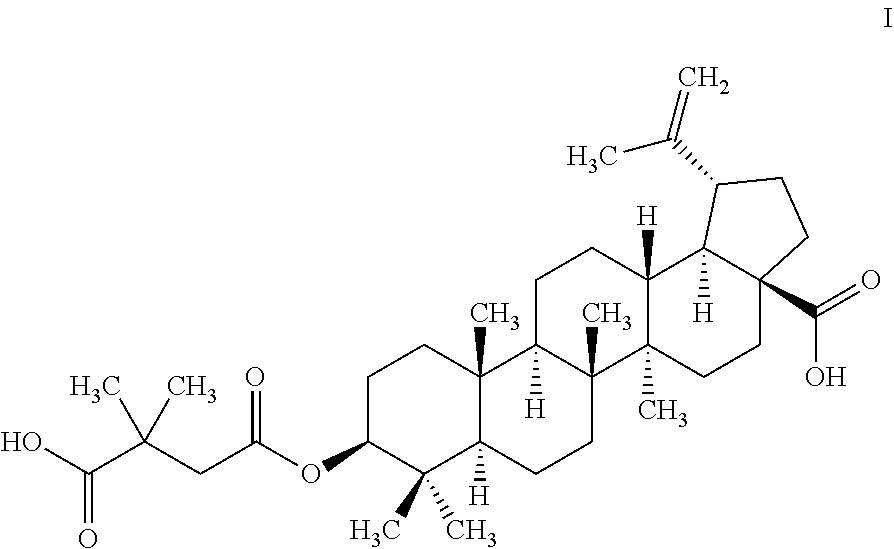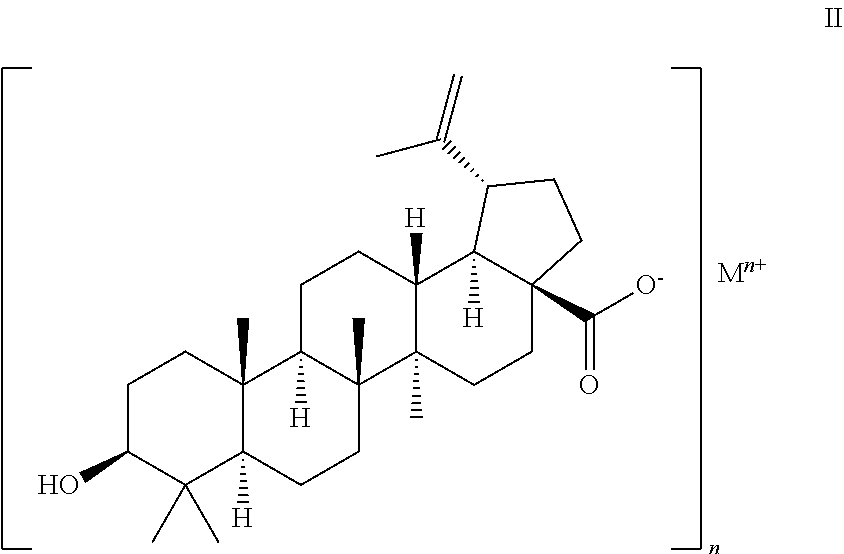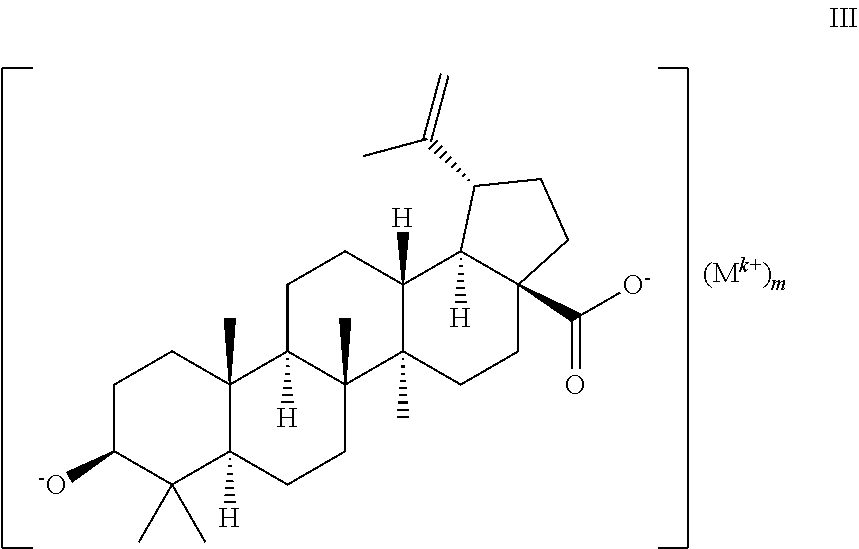Preparation of Pharmaceutical Salts of 3-0-(3',3'-Dimethylsuccinyl) Betulinic Acid
a technology of dimethylsuccinyl betulinic acid and pharmaceutical salts, which is applied in the field of preparation of 3o(3′, 3′dimethylsuccinyl) betulinic acid, can solve the problems of affecting the immune system of the body, and affecting the survival of patients
- Summary
- Abstract
- Description
- Claims
- Application Information
AI Technical Summary
Benefits of technology
Problems solved by technology
Method used
Image
Examples
example 1
[0101]A suspension of 219 g (1.5 mol) of 2,2-dimethylsuccinic acid in 220 mL of toluene is heated to 130° C. (oil bath) and 168.4 g (1.65 mol, 1.10 eq.) of acetic anhydride is added drop-wise over 1.5 h. During the addition the suspension becomes a solution. After all the anhydride is added, the solution is stirred for further 1.5 h at 130° C. in oil bath. Toluene is removed by distillation. Addition of 250 mL of toluene and repeated distillation will remove residual acetic acid and acetic anhydride. Yield: 178 g (93%) slightly yellowish oil which crystallizes upon standing. Purity by NMR: 97%, traces of toluene, acetic acid, acetic anhydride
example 2
[0102]A solution of 10 g (22 mmol) of betulinic acid in 42 mL of triethylamine preheated to 50° C. is added drop-wise to a suspension of 0.88 g (22 mmol) of NaH in 5 mL of triethylamine to form the sodium salt of 3-O-3′,3′-DSB. After addition is completed, triethylamine (23 mL) is distilled off, DMSA (7 g, 55 mmol) is added at 80° C. and the reaction mixture is refluxed. After 1.5 h HPLC indicates complete conversion and the suspension is cooled to 30° C. before it is carefully added to 75 mL of pre-cooled ethanol. Then, 45 mL of water followed by 30 mL of HCl (32%) are added and the product precipitates. The precipitate is filtered, washed with 100 mL of water and dried in vacuo at 50° C. overnight. Yield: 11.7 g (91%, crystals). HPLC: Betulinic acid: 0%; 3-O-3′,3′-DSB: 91.5%; 3-O-2′,2′-DSB: 8.5%.
example 3
[0103]Betulinic acid (100 g, 219 mmol) is dissolved in 900 mL of triethylamine preheated to 50° C. Sodium methoxide (30% in methanol; 39 g, 215 mmol, 0.98 eq) is added and the glassware is rinsed with an additional 15 mL of methanol. The suspension is heated to 65° C. and 100 mL of a mixture of methanol / triethylamine is distilled off. The oil bath is then heated to 100° C. and an additional 400 mL of solvent are removed. 2,2-Dimethylsuccinic anhydride (70 g, 547 mmol, 2.5 eq.) is added and the suspension becomes a solution. An additional 140 mL of triethylamine are distilled off to obtain a ratio of 1:2.6 (betulinic acid:triethylamine). After 3 h, HPLC indicates complete conversion. Toluene (660 mL) is added and 600 mL of solvent (triethylamine and toluene) are removed by distillation. An additional 320 mL of toluene are then added and 320 mL of solvent are removed by distillation. The reaction mixture is cooled to 20° C., and HCl 37% (54 g, 547 mmol, 2.5 eq.) is added slowly follow...
PUM
| Property | Measurement | Unit |
|---|---|---|
| melting point | aaaaa | aaaaa |
| melting point | aaaaa | aaaaa |
| melting point | aaaaa | aaaaa |
Abstract
Description
Claims
Application Information
 Login to View More
Login to View More - R&D
- Intellectual Property
- Life Sciences
- Materials
- Tech Scout
- Unparalleled Data Quality
- Higher Quality Content
- 60% Fewer Hallucinations
Browse by: Latest US Patents, China's latest patents, Technical Efficacy Thesaurus, Application Domain, Technology Topic, Popular Technical Reports.
© 2025 PatSnap. All rights reserved.Legal|Privacy policy|Modern Slavery Act Transparency Statement|Sitemap|About US| Contact US: help@patsnap.com



